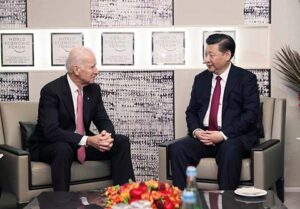The US administration has termed its rivalry with China the biggest geopolitical test of the century. US-China relations, characterised by a pattern of ups and downs over the past quarter-century, took an irreversible turn for the worse in 2019. President Barack Obama was the first US President to publicly acknowledge China’s economic might as a threat to the US’ global financial status, with its potential to surpass it in the future. He opted for the cooperation approach by convincing China to work as its junior partner in the region and the world. China declined because it wanted to be treated equally, in keeping with its transformed status and power potential. Under President Trump, the differences became more potent, when he fired the first shot by initiating trade wars with China. The bilateral ties of decades were transforming and enter a phase many called the beginning of a ‘New Cold War.’
Trump had called Obama’s cooperation strategy a sign of weakness and adopted a more aggressive stance. Interestingly, Biden has taken Trump’s policy to the next level; he has engineered a dramatic shift in American foreign policy since Richard Nixon went to China. The tensions threaten to engulf the entire world and could lead to an Armageddon-like clash between the two military and technology giants, warns Henry Kissinger, the architect of the 1971 warming of relations between the two countries. He added that it carries more risks than the Cold War with the Soviet Union, where the two rival superpowers used every possible means to pursue the conflict. Post-Cold War, the unipolar world created a power vacuum that gave birth to this strategic competition between the two countries.
The so-called ‘Biden Doctrine’ is “less interested in co-existence and more interested in dominance.” The openly stated task of American foreign policy is now not only to counter terrorism, but largely to blunt Chinese ambitions. America may work with China in areas of common interest but will counter it elsewhere. Biden’s decision to confront Beijing and make that confrontation central to his foreign policy makes good political sense for the US. China has emerged as the only peer competitor to the US in the last 30 years. The most aggressive moves being made by Biden against China are on the economic front. He has carried on with former President Donald Trump’s trade sanctions against Beijing and worked with the Senate to pass a massive quarter trillion-dollar industrial policy bill to boost US competitiveness. He launched a ‘Buy American Campaign’ that cuts foreign firms out of the highly lucrative US government procurement market; he has also worked to block Chinese acquisitions and investments inside the United States and keep Chinese students and researchers out of the country. In June 2021, President Biden signed an executive order banning Americans from investing in Chinese companies linked to any military or surveillance technology. Nearly 60% of the Americans now have an unfavourable view of the People’s Republic – a record high since the Pew Research Center began asking the question in 2005.

The US-China strategic rivalry has huge repercussions and implications for Pakistan. The US has both propped up India and invested in it to counterbalance China. Security and diplomatic cooperation between India and the US has been rising in recent years, particularly since Donald Trump became president. Consistent with American activism, India has been gradually shedding its long-held hesitation about being a proactive participant in militarising its alliance with the US, Japan and Australia against China’s expansion in the Indo-Pacific region. Both Washington and New Delhi characterised the Belt and Road Initiative (BRI) as a debt trap, much to China’s annoyance.
India’s developmental and diplomatic footprint in Afghanistan, that worked against Pakistan, had been made possible due to America’s military presence in Afghanistan. The conventional wisdom usually dished out to Pakistan to not place all its eggs in the Chinese basket and to resist pressures to side with China in the latest strategic rivalry with the United States, is becoming difficult to operationalize by the day. US-China tensions can complicate the delicate balance Pakistan has maintained between Washington and Beijing so far. Pakistan and India, the two protagonists in South Asia, will fall into opposite camps if the new cold war unfolds and risks to regional security are high. Chinese stakes in South Asia are also substantially high; Beijing’s efforts to go global since 2012 meant the subsequent expansion of Chinese activities beyond its borders and acceleration of building links with South Asia in new and more ambitious ways.
The US’ messy withdrawal from Afghanistan, the humiliating collapse of the US-propped up Ghani Government and the Afghan National Army, and the subsequent spectacular capture of power by the Taliban, has further strengthened China’s position in the region. China lost no time in offering the Taliban what they are seeking in return for safeguarding Chinese interest in Afghanistan and giving them the requisite economic foothold in Afghanistan, including access to its mineral deposits worth three trillion dollars. China emerged as one of the first nations to open diplomatic channels with the Taliban. The Taliban have also reassured China that post-war Afghanistan will welcome infrastructure and investment projects. They mentioned that “China is a friendly country, and we welcome it for reconstruction and developing Afghanistan.” China, in some ways, has already given de facto recognition to the Taliban. Criticism by the West that China is not concerned about the protection of human rights or the democratic process in Afghanistan sounds quite hollow in the wake of the US cut-and-run calendar instead of a condition-based withdrawal.

China’s strategic Belt and Road Initiative (BRI) could get more reach if it can extend it from Pakistan to Afghanistan via the Peshawar to Kabul motorway – a shorter land route for faster and convenient access to markets in the Middle East for Chinese goods. The path through Kabul also makes India’s reluctance to join the BRI less consequential.
Many see the withdrawal of the US from Afghanistan as yet another American retreat from Asia. China’s quick move into the vacuum created thus, and its subsequent welcome by the Taliban, who referred to it as the ‘leading partner’ who would help Afghanistan make an economic comeback, carries a lot of significance. In more ways than one, China has already given de-facto recognition to the Taliban’s capture of power. Add to this the Russian take on the situation; they have effortlessly transitioned into working with the Taliban. They have spoken positively of them so far and praised them for maintaining order in the capital. Russia is willing to engage with them, as long as they provide security guarantees for Central Asia and pledge to prevent terrorist attacks from Afghan territory, which they already have. A veteran Russian diplomat, Zamir Kabulov, went so far as to give the Taliban a better ranking than the previous government. He said, “if you compare the capacity of the two to make agreements with colleagues and partners, then the Taliban have long seemed to be far more capable than Kabul’s puppet government.” Russian President Putin has told his Chinese counterpart Xi that he shares China’s position on Afghanistan and its interests, and is willing to work with the Taliban to prevent any security risks from “spilling out” of Afghanistan.
This has completely changed the security matrix of the region and propelled the US into, once again, engaging with Pakistan. Leaked documents show that the Biden administration is quietly pressing Pakistan to cooperate in fighting the terrorist group. Losing a nuclear-armed country to China and having no influence over the Taliban is preventing the Biden administration from distancing itself from Pakistan.
Pakistan is very open to being both the US and China’s face of foreign policy in Afghanistan, provided its sensitivities and sensibilities are accommodated. The United States made the mistake of engaging with the wrong side in Afghanistan, which resulted in a debacle which it will have a hard time recovering from. Is the US committing the same mistake once again by engaging with India to balance the power equation in South Asia, at the expense of Pakistan? A rethink would help.

The writer is Chairperson & Associate Professor at IBA, and a leading commentator on political and foreign affairs.



